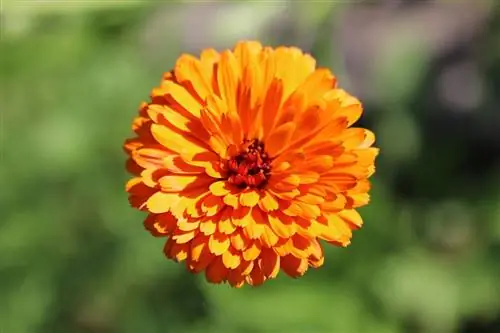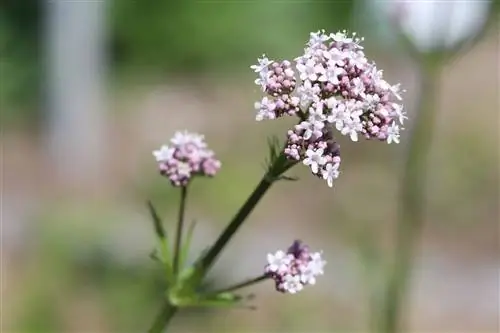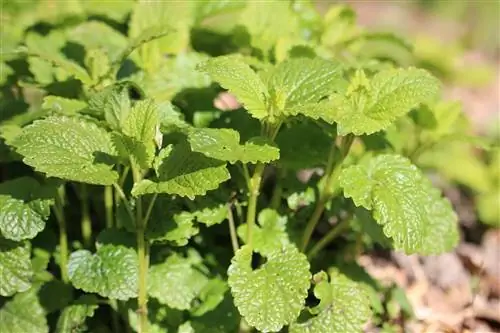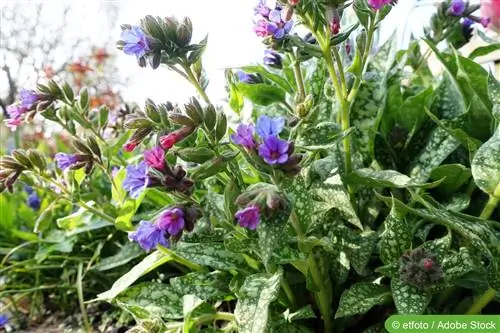- Author admin [email protected].
- Public 2023-12-17 03:39.
- Last modified 2025-01-24 12:45.
The soapwort or Saponaria officinalis, as its botanical name is, is a perennial. The plant can reach a height of 70 cm and has wonderful white to pink flowers. Spring and summer are the plant's main growing times. The name was given to the plant because the roots produce a soapy smell when crushed and also foam when combined with water.
Origin
The soapwort occurs in Europe and has also been discovered in Asia Minor, Central Asia, Japan and Siberia. Saponaria officinalis was introduced into North America at some point and has been growing in these areas ever since.
Appearance
The Saponaria officinalis is often referred to as the carnation plant because the basal axis is heavily branched, creeping and has runner-like properties. The stem is rather finely fluffy and can reach a height of 70 cm. The stems become more branchy in the upper area. The leaves are oppositely crossed. In addition, the leaves can be described as elongated and lanceolate. The flowers are located directly in the axils of the leaves and occur in groups of three to five. The flower itself has 10 stamens and an ovary. Especially in the evening, the flowers emit a wonderfully pleasant scent, which means that the Saponaria officinalis is visited by many butterflies. The flowering time for soapwort is June through September. The colors can be described from rose to light purple.
Sowing
The Saponaria officinalis is sown using seeds or can be propagated by division. If you want to plant Saponaria officinalis from seeds, you should ensure a planting distance of 40 cm. The plants have the best effect when planted in groups of 5 to 10. Since the plant is a perennial, it can also be used wonderfully for green roofs.
Location

So that the Saponaria officinalis can develop its full splendor, it is advisable to choose a sunny and bright place for the plant. The soil should be permeable and fresh. Preferably, clay-gravel soil is optimal. The pH value is ideally between 5 and 7. The Saponaria officinalis is very hardy and can survive temperatures down to -35 °C without damage. However, it absolutely needs a frost-free period of at least 19 weeks. Perfect locations are open spaces where so-called bee meadows can be created or edges of trees. The plant offers a high level of tolerance if the soil is a little dry at times.
Plants
Due to its growth characteristics, planting in a pot should be avoided. If you plant Saponaria officinalis, it should already be in the garden or in an open field.
Pouring
Due to its origin, Saponaria officinalis needs a lot but not too much water. The plant usually grows optimally when it is located on the banks of water. If you have a pond in your garden, you can plant soapwort directly on the bank. But the location can also be on walls and fences, where you should, however, make sure to supply the plant with enough water.
Fertilize
You can use a complete fertilizer for fertilizing. However, you should only fertilize the Saponaria officinalis once a year, as too much nutrients damage the plant.
Tip:
If you don't want to use chemical fertilizer, you can simply make a manure using nettles and a water mixture, which can be used optimally as a fertilizer and as a pest killer.
Cutting
The soapwort is ideal for use in gardens as a perennial plant. Even if the plant appears to be very robust and requires little care, you should cut back the Saponaria officinalis in autumn. Once the flowering period is over, the plant is left alone for a while before you can cut it back to a hand's width above the ground.
Wintering
You don't have to follow any special instructions when wintering. The Saponaria officinalis can tolerate temperatures down to -35 °C and can easily survive the winter in Germany without any difficulties.
Propagate
If you want to propagate the Saponaria officinalis, re-sowing and root division are necessary. If you simply let the plant grow, it will reproduce through a vegetative system. Unwanted propagation can easily be prevented by removing the roots from the soil at least once a year.
Diseases and pests
In rare cases, Saponaria officinalis can become infected with a fungus. If you discover a fungal disease, the affected areas must be removed immediately. You can recognize mushrooms by the round brown spots that are usually found on the leaves. You should also treat the Saponaria officinalis with a fungicide to protect the other plants in the garden from infestation.
Summary
The soapwort enchants every garden with its wonderful flowers. What is particularly striking is the fragrant scent, which is particularly noticeable in the evening hours. Below you will find an overview of all the properties of Saponaria officinalis:
- Growth height up to 70 cm
- hardy down to -35 °C
- easy care
- optimal location sunny and near the shore
- also suitable for walls, but in this case don't forget to water sufficiently
Frequently asked questions
Can Saponaria officinalis be planted with other plants?
In order to preserve the unique beauty of the plant, it is advisable that the Saponaria officinalis is only planted alone or in a group of 5 to 10 plants. An alternative is to plant different species of the Saponaria officinalis family. However, mixing it with other plant species is not recommended.
Can Saponaria officinalis also be planted in a pot?
Basically, you can cultivate all plants as potted plants. You just have to make sure that the roots have enough space to spread out well. In the case of Saponaria officinalis, a top with a diameter of 30 to 40 cm makes sense. However, the care required for a potted plant is significantly higher. The dense growth of Saponaria officinalis will make it difficult to keep in a pot. It therefore makes more sense to cultivate Saponaria officinalis only outdoors or in the garden.
What to do if there is waterlogging?
It often happens that a lot of rain falls in our latitude. To prevent waterlogging right from the start, you should strictly adhere to the specifications for the optimal location. If waterlogging does occur, you should immediately ensure that the excess water can reach other areas. Work the soil and enrich it with gravel so that the soil becomes more permeable.
What you should know about soapwort in brief
- The real or common soapwort (Saponaria officinalis) was used as a detergent in ancient times, especially for wool and clothing with a sensitive color.
- It is also called soap root or wax root. Nowadays, however, this plant plays a major role, especially in natural medicine, and is therefore specifically cultivated in some countries.
- The roots and their rhizomes, which contain saponins, are used from this plant. Small pieces of this root can be used to soap laundry items to make them easier to clean.
- The roots are also used in medicine, but sometimes the herb is also used. It is mainly used for bronchial problems to loosen mucus.
Tip:
You can drink a tea made from the roots of the soapwort.
There are now also some ready-made preparations on the market. As a home remedy, soapwort is also used for skin problems or as a diuretic. However, an overdose must be avoided at all costs because soapwort is slightly poisonous and in higher doses can cause vomiting and problems with the digestive tract.






